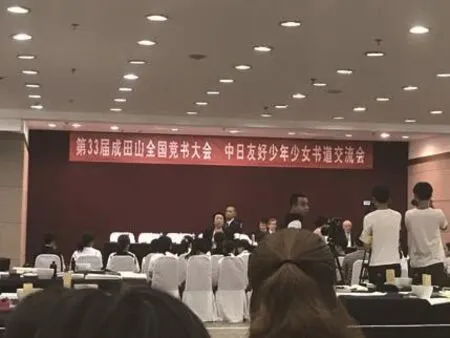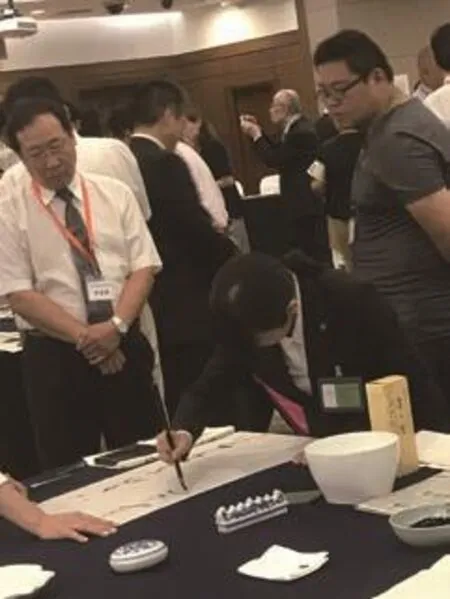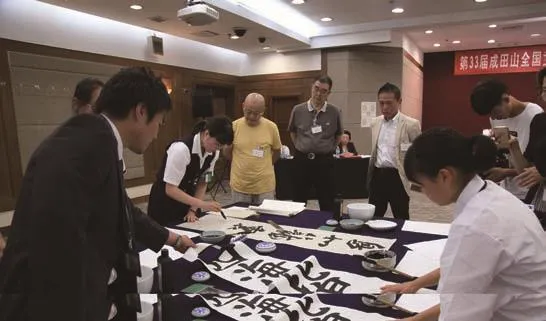传统之派与现代之风的碰撞
——记第33届成田山全国竞书大会中日友好青少年书法交流活动
文、图本刊实习记者 杨阳 Yang Yang 译曹宇光Cao Yuguang
有着你方写罢我方登场的竞相比赛意味,也有着一方挥毫书写时另一方小朋友帮其整理纸张、墨盘的互助温暖时刻……这些场景均发生在第33届成田山全国竞书大会中日友好青少年书法交流活动上。应中国书协邀请,由日本成田山全国竞书大会副会长、成田山新胜寺寺务长岸田照泰率领的第33届成田山全国竞书大会中日友好少年少女书法交流团一行46人于8月4日至8月7日来华交流访问,8月5日在北京举行了中日青少年书法交流笔会。
成田山全国竞书大会成立于1985年,每年在日本举办一次全国性的书法竞赛,征集全国中小学生及幼儿学生的书法作品,由日本著名书法家对征集书法作品进行评选。33年来,共约有70万青少年参加书法竞赛活动,约300余万件作品应征,成为日本国内最具影响的青少年书法竞赛活动。成田山全国竞书大会每年组织竞赛获奖青少年访华交流。
荣获中国书协颁发“兰亭新星”奖的高中三年级学生大田千寻也在此次日方参加交流笔会的14名学生中,交流团其他成员实力也不容小觑,均是2017年日本全国书法竞赛的优胜者。中方参加交流的14名学生来自北京市朝阳、海淀、东城等区的小学、初中、高中的学生,最小的仅11岁,都有着扎实的习书功底。
中国书协副主席何奇耶徒表示:“书法艺术是人类的非物质文化遗产。保护、传承、弘扬这一人类非物质文化遗产是世界书法界的共同责任。组织青少年书法比赛,广泛深入开展国际青少年书法交流,是弘扬书法艺术的一条重要举措。我们衷心希望中日青少年书法交流活动长期开展,生生不息,代代相传。”
中日青少年学生当场同台挥毫泼墨,开展笔会交流。先是日方学生进行书写,之后中方学生进行书写,最后双方共同书写。在这样的书写安排中,你方写罢,我方登场,每一位小作者分别即兴创作一幅书法作品,竞写意味浓厚。双方学生在书写过程中,不时进行交流,相互帮助整理纸张、墨盘等,体现了双方学生的友好与热情,也表达了此次交流笔会的主旨目的。
日本书道同中国书法一样,在习书过程中都绕不开“书圣”王羲之。在六朝时期王羲之书法便被引入日本,经过千百年的演进,今日日本书道与中国书法面貌已全然不同,形成了花开两朵、各表一枝的局面。在你来我往的笔锋碰撞中,可窥见日方作品所呈现面貌已与中国学生作品大为不同。
就用笔而言,中方学生在一点一画之间,笔法更为丰富。藏锋与斜切入笔相间、变化丰富,落笔之后,笔尖徐行涩势,是中方学生习字之态;日方学生落笔干脆、利落,走笔如行云流水,酣畅淋漓。在中日双方学生的作品中,更为明显的不同是双方对于作品布局的处理。“哇,写得真有气势!”中方学生王新源在看到日方的金良健之介的现场作品《笔魂海邦》之后惊叹。相比于中国书者在写作品时会“上留天,下留地”,更会留出落款之地相比,日方书法作品是将整个篇幅填充饱满,气势为先,给人以强烈的视觉冲击。
中日双方书法同出王羲之一路,如今却呈现出完全不同的风格,这是两国发展书法的立足点不同的缘故:中国书法向来“以古为尊”,千百年来一直将“学习先人,立足传统”作为书学要义,属于传统之派。而日本方面,在发展书学的过程中,学古而不止于古,将现代之气融入书道中,开启了书法的现代之风。此次笔会交流,让传统之派和现代之风进行了一次实实在在的碰撞,在这样的交流碰撞之后,相信双方在今后的书法学习中会进行更多的思考。
“田村茜同学的创作令我十分感动,她在书写作品时将其指导老师的遗像放在了旁边。在中日交流笔会这样重大的现场,田村茜同学将导师的遗像带过来,充分体现了其对老师的敬重、爱戴之情,也深深体现了学书者所应具备的尊师重道之品质。”中国书协理事李一在点评作品时说。他还鼓励两国青少年通过交流,切磋技艺,相互学习,领悟书法的真谛,将来成为传承书法艺术的栋梁。

笔会现场Scene of the Calligraphy Exchange
There was a fierce competition between every participant,and there was a warm moment when the rival kids helped one another with paper and ink preparation. Both took place in the China-Japan Friendship Teenager Calligraphy Exchange of the 33rdJapanese Naritasan National Calligraphy Competition (JNNCC). At the invitation of China Calligraphers Association (CCA),a 46-member Japan-China Friendship Teenager Calligraphy Exchange delegation, headed by Kishida Teruyasu,vice president of JNNCC and CEO of Shinshoji Temple, visited China for exchanges from August 4 till 7. On August 5, China-Japan Teenager Calligraphy Exchange was held in Beijing.
Initiated in 1985, JNNCC is an annual nationwide calligraphy competition in Japan that collects calligraphic works by pupils of primary and secondary schools and even kindergartens for final comments by renowned Japanese calligraphers. In the past 33 years, approximately 700000 teenagers have participated in this competition with some 3 million pieces of calligraphy, much so so that JNNCC has become the most influential teenager calligraphy competition in Japan. Every year, the organizing committee of JNNCC sends a delegation of award-winners to China for exchange.
Oota Chihiro, a student of grade three of high school who has won “Lanting New Star Award” by CCA, was one of the 14 delegates from Japan. As for others, they are all winners of nationwide calligraphy competitions in Japan in 2017 and thus proven as blessed with outstanding talents in calligraphy. As for Chinese side, the 14 attendees were all students of elementary and secondary schools from Chaoyang, Haidian and Dongcheng Districts of Beijing. Though the youngest was only at the age of eleven, they were invariably qualified with a solid foundation of calligraphy.
He Qiyetu, vice president of CCA, remarked at his speech, “As calligraphy is an intangible cultural heritage of mankind, it has become a common responsibility for the global calligraphy community to preserve, inherit and promote this art. It is indeed an important measure of promoting calligraphy as an art to organize teenagers’ calligraphy competition and conduct extensive exchanges on the international occasion. We sincerely expect that teenagers’ calligraphy exchange between China and Japan may witness constant development from generation to generation”.
It was an improvised calligraphy exchange on the same arena jointly by teenagers from China and Japan. As guests, Japanese delegates took the lead and then Chinese peers followed in the final co-production. Though such a situation was quite like a fierce competition between athletes, those young calligraphers talked with each other from time to time and helped each other with paper and ink preparation when ever necessary. Such good manners showcased friendship and enthusiasm between teenagers of the two countries and fulfilled the theme purpose of this exchange.
In Japanese calligraphy and Chinese calligraphy, WANG Xizhi, the Saint Master of Calligraphy, is a must-known sample to follow in the process of calligraphy practice. As early as in the 3rdcentury, WANG Xizhi’s calligraphy was introduced to Japan. Having undergone a significant evolution through centuries, today’s Japanese calligraphy has presented a totally different outlook from that in China. From those teenagers’improvised calligraphy, we can obviously see a sharp contrast between calligraphy development tendencies in China and Japan.
As to the style of calligraphy, Chinese side seemed to have more abundant variety in dots and strikes. Upon first touch of brush tip on paper, Chinese teenagers will choose varied movements in gradual intensification. By contrast, Japanese teenagers will never hesitate on the first touch and write with natural grace at a dash. Certainly, the obvious difference lied in the layout of their calligraphy works. “Wow, what an imposing manner!” WANG Xinyuan, a Chinese teenager acclaimed at the sight of the improvised calligraphy by Kinra Kennosuke from Japan. Compared with the elegant blank in the above and below margins of any calligraphy works in Chinese habit, Japanese calligraphers prefer to fill the whole scrip as much as possible and their momentum causes a strong visual impact.
Though out of the same origin as WANG Xizhi, Chinese and Japanese calligraphies have presented different styles at present, which is mainly attributed to their different positions in calligraphy development. With dominant respect for the ancient samples and traditions for thousands of years, Chinese calligraphy prefers tradition. In the Japanese process of calligraphy learning, they are never satisfied with mere copying and are courageous enough to integrate modernity into the new fashion of calligraphy.This exchange was indeed a collision between the school of tradition and the fashion of modernity, and it was believed that both sides would gain more by doing more thinking in the future calligraphy practice.
“I must mention Tamura Akane whose action moved me greatly. Before she started writing her works, she took out the frame photo of her tutor who had just passed away and respectfully placed it in front of her. Such a considerate act in this significant event of China-Japan calligraphy exchange fully embodied her adoration and love for her tutor,and deeply represented the basic quality of respecting the teacher and revering teachings for any calligraphers.” LI Yi, advisor of CCA, commented. He also encouraged teenagers of China and Japan to master the true essence of calligraphy by mutual learning and reference, and thus become the backbone for calligraphy inheritance.

笔会现场Scene of the Calligraphy Exchange



